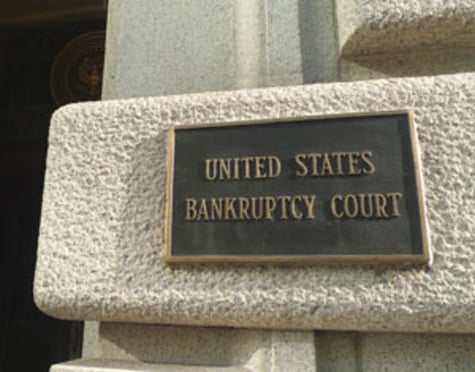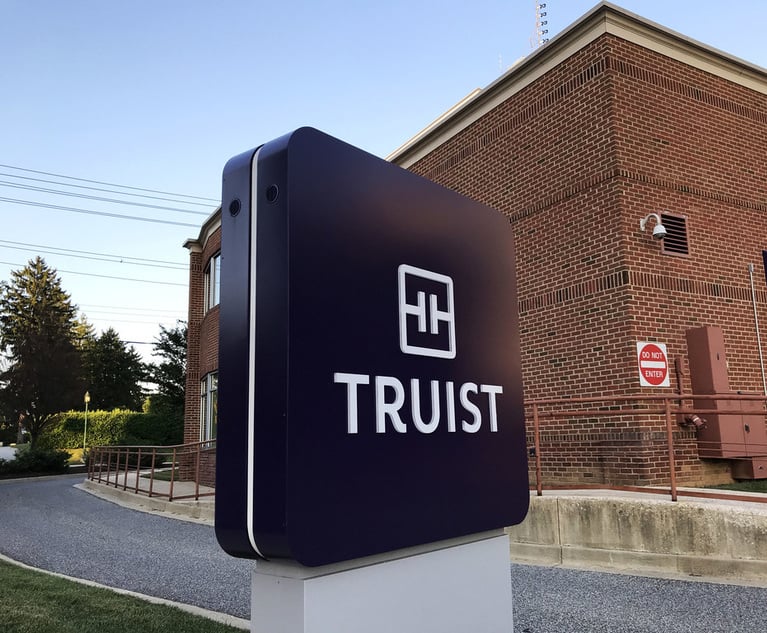Prepetition Setoff Not an 'Improvement in Position' Under Bankruptcy Code
In a recent decision out of the United States Bankruptcy Court for the Western District of Virginia, a court analyzed the effect of a setoff effectuated between two governmental units in the 90 days prior to the filing of a husband and wife's bankruptcy case.
May 24, 2018 at 01:51 PM
8 minute read

In a recent decision out of the U.S. Bankruptcy Court for the Western District of Virginia, a court analyzed the effect of a setoff effectuated between two governmental units in the 90 days prior to the filing of a husband and wife's bankruptcy case. In Hurt v. U.S. Department of Housing and Urban Development (In re Hurt), 579 B.R. 765 (Bankr. W.D. Va. 2017), the court addressed competing motions for summary judgment filed by the debtors, on the one hand, and the U.S. Department of Housing and Urban Development (HUD), on the other hand, in an adversary proceeding instituted by the debtors seeking to avoid a prepetition setoff of the debtors' tax refund on account of a debt owing to HUD. In ruling in favor of HUD, the court found that a pre-petition setoff is not avoidable as a preference under Section 547 of the Bankruptcy Code, and HUD did not “improve its position” vis-à-vis the debtors within the scope of Section 553(b) of the Bankruptcy Code, and therefore the setoff was appropriate and not avoidable by the debtors.
Facts and Arguments of the Parties
Before filing for bankruptcy protection, Adam Hurt obtained a loan from HUD, a U.S. government agency, in the principal amount of $38,463. This loan ultimately fell into arrears, and HUD sent the Hurts a notice of intent to collect by treasury offset. Pursuant to this notice, HUD alerted the Hurts of HUD's intention to seek to offset any amounts owed to the Hurts by the treasury (another U.S. government agency).
The Hurts filed for bankruptcy protection in March 2017, but before doing so, they filed their 2016 income tax return. The Internal Revenue Service (IRS), which is a part of the Treasury Department, determined that the Hurts had overpaid their 2016 income taxes, and were owed a refund on account thereof in the amount of $5,267. As of January 2017, the Hurts owed $19,653.38 to HUD on account of their loan. On Feb. 23, 2017, in advance of the date on which the Hurts filed their bankruptcy petition, the treasury processed the offset request from HUD and turned over to HUD the full amount of the Hurts' 2016 tax refund to satisfy a portion of the Hurts' indebtedness to HUD.
In their bankruptcy petition and schedules, the Hurts listed their 2016 tax refund as exempt. In order to recover the 2016 tax refund, the Hurts filed an adversary proceeding against HUD under 11 U.S.C. Section 547(b), seeking avoidance of the setoff between the treasury and HUD. The Hurts then filed a motion for summary judgment on their claims, and HUD cross-moved for summary judgment, asserting that the setoff was not recoverable by the debtors under Section 547 Bankruptcy Code, and further that the setoff was not recoverable under 11 U.S.C. Section 553, which is the Bankruptcy Code section governing setoffs.
The Court's Analysis
The court first addressed whether the Hurts could recover the amount of their 2016 tax refund from HUD as an avoidable preference under Section 547 of the Bankruptcy Code. In analyzing this issue, the court noted that in order to avoid and recover a preferential payment, Section 547(b) of the Bankruptcy Code requires that the amount to be avoided be a “prepetition 'transfer' of an interest of the debtor in property.” The court took note of the fact that the Bankruptcy Code specifically defines the term “transfer” and, in a recent revision to the Bankruptcy Code, Congress removed the term “setoff” from this definition. The court cited the legislative history with respect to this change, which provided that “inclusion of 'setoff' is deleted. The effect is that a 'setoff' is not subject to being set aside as a preferential 'transfer' but will be subject to special rules.” Accordingly, the court found clear instruction from the Bankruptcy Code that the setoff between HUD and Treasury was not a preferential “transfer” that could be avoidable under Section 547 of the code.
Although the Hurts did not raise the argument in their complaint, HUD asserted in its cross-motion for summary judgment that the Hurts could not recover the setoff between HUD and the treasury under Bankruptcy Code Section 553, which is the specific provision in the Bankruptcy Code governing setoff. It is important to note that Section 553 does not create a right of setoff, but rather recognizes that such a right exists; additionally, Section 553 limits the exercise of a party's setoff rights to certain circumstances. As relevant here, Section 553(b) provides that a pre-bankruptcy setoff may be recovered by a debtor's estate where the creditor improved its position with respect to any insufficiency between the mutual debts between the parties within the 90 days prior to the bankruptcy filing. For purposes of this section, “insufficiency” is defined in Section 553(b)(2) as the “amount, if any, by which a claim against the debtor exceeds a mutual debt owing to the debtor by a holder of such claim.”
The Hurts argued that Section 553 required the avoidance of the setoff because at the beginning of the 90 day period, HUD was owed $19,653.38, but as of the date that the Hurts filed their bankruptcy petition, HUD's position had improved, as it was owed only $14,386.38—the difference between the two amounts being the Hurts' 2016 tax refund. This analysis, however, failed to address the “insufficiency” concept in Section 553.
Contrary to the Hurts' argument, the court found that there was no “insufficiency” between the Hurts and the government on Dec. 3, 2016—the beginning of the 90-day period—because the Hurts' 2016 tax refund did not become a debt owed to the Hurts by the government until Dec. 31, 2016, the last day of the tax year at issue. Accordingly, at the outset of the 90-day statutory period, there was no insufficiency between mutual debts, because there were no mutual debts between the Hurts and the government at all at that time. Rather, on Dec. 3, 2016, the Hurts simply owed the government $19,653.38 on account of the HUD loan, and the government owed nothing to the Hurts.
During the 90-day period, however, a mutual debt did arise when the Hurts became entitled to their 2016 tax refund. The creation of an insufficiency in mutual debts during the 90-day period prior to a debtor's petition date does not impact the right to setoff under Section 553. Rather, if a mutual debt arises during the 90-day period, there would only be an improper improvement in the creditor's position if the insufficiency were less on the petition date than it was on the date that such insufficiency arose.
In completing the analysis required by Section 553, the court determined that on Dec. 31, 2016, an insufficiency of $14,386.38 arose. This insufficiency was the difference between what the Hurts owed HUD ($19,653.38), and what the treasury owed the Hurts as of that date ($5,267.00). Because the government's claim against the Hurts as of the petition date was the same amount as the insufficiency that arose during the 90-day period ($14,386.38), the court concluded that the government had not improved its position with respect to the Hurts during the 90-day period, that the setoff was therefore not recoverable by the Hurts in the bankruptcy case.
Conclusion
The rule of setoff, as explained by the Hurt court, does not appear to articulate much more than the fact that a creditor may avail itself of the right to set off up to the amount of the debt owed to it during the ninety days prior to a debtor's bankruptcy case. In drafting Section 553 and removing “setoff” from the type of transaction that can be avoided as a preference under Section 547, Congress manifested its intent to allow setoffs within 90 days before a bankruptcy filing. However, the result of Congress' drafting might, in some instances, create a problem for creditors with setoff rights. For example, if the Hurts had made a payment to HUD in the amount of $5,000 after Dec. 31, 2016, thereby reducing the insufficiency that was created on that date, and HUD later effectuated its setoff with the treasury, HUD's insufficiency on the petition date would have been $5,000 less than it was on the date that the insufficiency arose. This would allow the Hurts to recover the $5,000 payment under Section 553, apparently regardless of whether HUD had a valid defense to the preferential transfer, such as the provision of new value under Section 547(c)(4) of the Bankruptcy Code, or that the payment was made in the ordinary course of business under Section 547(c)(2). As such, creditors with setoff rights might find themselves in a worse position than other creditors if the insufficiency is diminished (i.e., if they receive some form of payment) before they exercise setoff rights. As a general rule, therefore, creditors with setoff rights would be well advised to exercise those rights as soon as possible in order to avoid the hypothetical scenario described above.
Rudolph J. Di Massa Jr., a partner at Duane Morris, is a member of the business reorganization and financial restructuring practice group. He concentrates his practice in the areas of commercial litigation and creditors' rights.
Catherine B. Heitzenrater, an associate with the firm, practices in the areas of bankruptcy, corporate reorganization, creditors' rights, commercial finance and secured transactions.
This content has been archived. It is available through our partners, LexisNexis® and Bloomberg Law.
To view this content, please continue to their sites.
Not a Lexis Subscriber?
Subscribe Now
Not a Bloomberg Law Subscriber?
Subscribe Now
NOT FOR REPRINT
© 2025 ALM Global, LLC, All Rights Reserved. Request academic re-use from www.copyright.com. All other uses, submit a request to [email protected]. For more information visit Asset & Logo Licensing.
You Might Like
View All
Federal Judge Allows Elderly Woman's Consumer Protection Suit to Proceed Against Citizens Bank
5 minute read
Dilworth Paxson Launches Erie Office With Longtime Local Banking Attorney
4 minute read
Stradley Ronon Bolsters Investment Management Practice With Vanguard Hire
4 minute readTrending Stories
- 1Bar Groups Say IOLA Settlement Protects Civil Litigants' Fund From Future 'Raids'
- 2'Every MAGA Will Buy It:' Elon Musk Featured in Miami Crypto Lawsuit
- 3Pennsylvania Law Schools Are Seeing Double-Digit Boosts in 2025 Applications
- 4Meta’s New Content Guidelines May Result in Increased Defamation Lawsuits Among Users
- 5State Court Rejects Uber's Attempt to Move IP Suit to Latin America
Who Got The Work
J. Brugh Lower of Gibbons has entered an appearance for industrial equipment supplier Devco Corporation in a pending trademark infringement lawsuit. The suit, accusing the defendant of selling knock-off Graco products, was filed Dec. 18 in New Jersey District Court by Rivkin Radler on behalf of Graco Inc. and Graco Minnesota. The case, assigned to U.S. District Judge Zahid N. Quraishi, is 3:24-cv-11294, Graco Inc. et al v. Devco Corporation.
Who Got The Work
Rebecca Maller-Stein and Kent A. Yalowitz of Arnold & Porter Kaye Scholer have entered their appearances for Hanaco Venture Capital and its executives, Lior Prosor and David Frankel, in a pending securities lawsuit. The action, filed on Dec. 24 in New York Southern District Court by Zell, Aron & Co. on behalf of Goldeneye Advisors, accuses the defendants of negligently and fraudulently managing the plaintiff's $1 million investment. The case, assigned to U.S. District Judge Vernon S. Broderick, is 1:24-cv-09918, Goldeneye Advisors, LLC v. Hanaco Venture Capital, Ltd. et al.
Who Got The Work
Attorneys from A&O Shearman has stepped in as defense counsel for Toronto-Dominion Bank and other defendants in a pending securities class action. The suit, filed Dec. 11 in New York Southern District Court by Bleichmar Fonti & Auld, accuses the defendants of concealing the bank's 'pervasive' deficiencies in regards to its compliance with the Bank Secrecy Act and the quality of its anti-money laundering controls. The case, assigned to U.S. District Judge Arun Subramanian, is 1:24-cv-09445, Gonzalez v. The Toronto-Dominion Bank et al.
Who Got The Work
Crown Castle International, a Pennsylvania company providing shared communications infrastructure, has turned to Luke D. Wolf of Gordon Rees Scully Mansukhani to fend off a pending breach-of-contract lawsuit. The court action, filed Nov. 25 in Michigan Eastern District Court by Hooper Hathaway PC on behalf of The Town Residences LLC, accuses Crown Castle of failing to transfer approximately $30,000 in utility payments from T-Mobile in breach of a roof-top lease and assignment agreement. The case, assigned to U.S. District Judge Susan K. Declercq, is 2:24-cv-13131, The Town Residences LLC v. T-Mobile US, Inc. et al.
Who Got The Work
Wilfred P. Coronato and Daniel M. Schwartz of McCarter & English have stepped in as defense counsel to Electrolux Home Products Inc. in a pending product liability lawsuit. The court action, filed Nov. 26 in New York Eastern District Court by Poulos Lopiccolo PC and Nagel Rice LLP on behalf of David Stern, alleges that the defendant's refrigerators’ drawers and shelving repeatedly break and fall apart within months after purchase. The case, assigned to U.S. District Judge Joan M. Azrack, is 2:24-cv-08204, Stern v. Electrolux Home Products, Inc.
Featured Firms
Law Offices of Gary Martin Hays & Associates, P.C.
(470) 294-1674
Law Offices of Mark E. Salomone
(857) 444-6468
Smith & Hassler
(713) 739-1250






